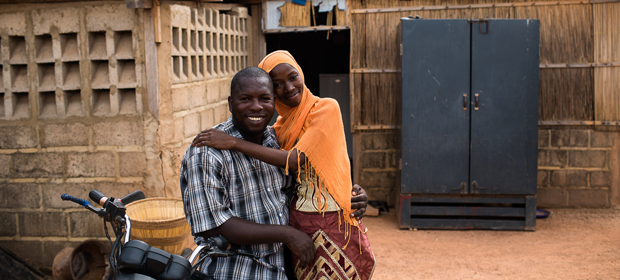Where We Work
See our interactive map


A newlywed couple in Ouagadougou, Burkina Faso, is looking to the future. Sub-Saharan Africa has the largest proportion of young people in the world. Photo by Trevor Snapp for IntraHealth International.
To make family planning work for young people, we need to look at the bigger picture.
Imagine you are very, very poor. You and your family have, say, $100 or less for the entire month. What are your priorities?
For most people, the main concerns would be food, safe drinking water, shelter, and maybe education, if there’s anything left over. When you’re making decisions under this type of pressure, a lot of important things fall to the bottom of the list.
Contraception is one of them.
In the global health community, we call the hardships that dog impoverished families “economic barriers.” We wring our hands over them because they get in the way of our progress toward making contraception and family planning services available to more people, and hinder the prosperity and global health progress that come with that access.
But for millions of families living in poverty, what we call economic barriers are simply the realities of life—humdrum hurdles to be cleared day after day.
Contraception can affect all these issues, but it goes both ways.
Francophone West Africa, where I come from, is one of the poorest regions in Africa. It’s also among those with the largest proportion of young people in the world. Over 70% of the population in sub-Saharan Africa was under 30 in 2012. That adds up to millions of young people who are full of dreams for their futures and working hard to make decisions that will serve them for a lifetime.
In some of these decisions—as you can imagine, if you are or once were young—access to contraception can come in very handy.
Global health experts know that if we were to reach a point where every pregnancy was wanted, and where all unmet need for contraception around the world were finally met, 30% of maternal morbidity and mortality would be eliminated. Infant and child mortality would plummet, global gender equality would rise, and social and economic development would flourish.
Contraception can affect all these issues. But it goes both ways. Too often we forget in global health that we cannot reach this state by focusing only on family planning.
We have to look at the bigger picture.
Our funding mechanisms for international development—which usually consist of disparate pots of money devoted to one or another specific disease or issue—are dangerously myopic, and encourage us to work that way. But dozens of factors that have seemingly nothing to do with sex can affect access to contraception every day, and we shouldn’t ignore them.
What about literacy? (The World Bank reports that more than half the population is illiterate in seven countries, almost all of them in West Africa.) Unemployment? (Global youth unemployment stood at 13% between 2012 and 2014, and two in five economically active young people are either underemployed or working but living in poverty.) Gender equality? (The global average gender pay gap is 17%, though it ranges from 3% to 51% around the world.) Agriculture? The environment? Technology?
The list is long.
If we want to achieve any of the global Sustainable Development Goals—including goal 3, which aims to ensure universal access to health care, including reproductive health services, by 2030—we need to be creative about it. None of us can transform global health and development all by ourselves, and we can’t do it without paying close attention to the many factors that affect health and well-being.
So it’s time to work together in bold new ways, to bring together experts from different sectors and fields and work toward our global goals holistically.
We’re already catching glimpses of this new cooperative approach in our field, for instance in the new partnership between the nonprofit global health organization IntraHealth International and the for-profit global development organization DAI. This partnership is something new, both for us and for the world of international development. It’s not a merger or acquisition. It’s a unique affiliation agreement that will help us work together toward new advances in global health.
And fortunately, there are many partnerships now working specifically to make contraception more widely available. FP2020, for instance, launched in 2012 as a global commitment among governments, civil society, multilateral organizations, donors, the private sector, and the research and development community to enable 120 million more women and girls to use contraceptives by 2020. The Ouagadougou Partnership is another, a coalition working to give 2.2 million more people in the francophone West African region access to family planning by 2020.
I’m confident that, together and in partnership with young people around the world, we can remove the hurdles that stand between our young population and the healthy, prosperous futures they envision for themselves.
Join the conversation for World Contraception Day 2017: #WCD2017 #HealthWorkersCount
This post originally appeared on HuffPost.
Get the latest updates from the blog and eNews




